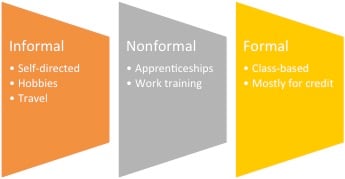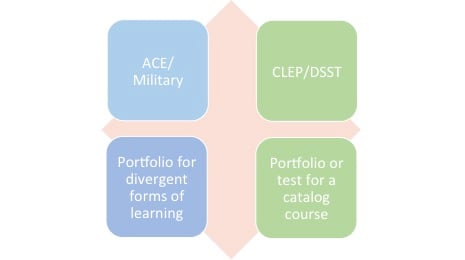Published on
PLA and the Completion Agenda: Understanding PLA

The practice of prior learning assessment (PLA) has grown in visibility as the nation wakes up to the importance of helping more adult students to complete their degrees.
The completion agenda
Time and cost to completion are major barriers for adult students to complete their degrees. From the report “Time is the Enemy” by Complete College America (2011):
There is a new American majority on campus. Seventy-five percent of today’s students are juggling some combination of families, jobs, and school while commuting to class; according to the U.S. Department of Education, only a quarter go full-time, attend residential colleges, and have most of their bills paid by their parents.
Part-time students rarely graduate. Even when given twice as long to complete certificates and degrees, no more than a quarter ever make it to graduation day.
The Big Idea: Time is the enemy of college completion. These historic data have revealed a common thread — and an animating principle to guide our work to boost college graduation: The longer it takes, the more life gets in the way of success.
PLA is catching on as a solution to this problem. The opportunity to use non-collegiate learning to gain credits toward the degree helps adult students save both time and money. Fain (2012) indicates, “prior learning is poised to break into the mainstream in a big way. The national college completion push and the expanding adult student market are driving the growth.”
What is PLA?
Learning takes place in many settings throughout life (OECD, 2015). Given the prevalence of informal and non-formal learning in the lives of adults, it is vital that we consider ways of bringing the college-level learning from these sources into the college experience for adults.
PLA takes a variety of forms in the U.S. The dominant forms include testing (such as the College Level Entrance Placement (CLEP), Dantes Standardized Subject Test (DSST)), learning evaluated by the American Council on Education (ACE), and the portfolio forms of PLA. The standards set by the Council for Adult and Experiential Learning (CAEL) are a widely accepted source for PLA practice (Fidler et al, 2006). The most important of these is this principle: “Credit or its equivalent should be awarded only for learning, and not for experience.”
Student Centered PLA
Faculty assessment of student learning from experience for college equivalency
ACE and Military Credit
The robust system developed between the American Council on Education (ACE) and the military and certain other organizations provides a path for work-related education to apply directly to college credits, often to elective requirements. Military students can supply their Joint Services Transcript and apply their knowledge gained in military education to their college degrees at most U.S. institutions. A range of employers, organizations, and union/industry apprenticeship programs have had their programs evaluated by ACE and carry a credit recommendation, found on the ACE National Guide to College Credit for Workforce Training.
Prior Learning Portfolio for Divergent Forms of Learning
In one portfolio form of PLA, the credit award follows the forms of the student’s non-formal and informal learning and typically meets general elective requirements. Students develop a portfolio of the learning gained and organize the learning essays and evidence into broad subject areas without making a claim to having learning equal to a specific catalog course. The equivalent in most curricula would be learning gained in internships or special topics courses.
University Centered
Based on course requirements, content, and learning objectives set by faculty
Tests
PLA takes a number of forms, and each can contribute to degree completion. CLEP and DSST exams are a form with broad participation. CLEP administered 176,000 exams in 2013-14. Nearly a majority of the test takers were adult students (Schmitz, 2014). Better than 40,000 Department of Defense personnel took DSST exams in the 2014 fiscal year (DANTES, 2014). Many colleges and universities have a system that goes beyond this for students to “test-out” of some courses (e.g., world languages, IT).
Course-specific PLA
The portfolio form of PLA provides a way for adult students to translate the learning they have gained through their experiences to college credit. These systems sometimes require the students to develop a portfolio that demonstrates that they have a sufficient base of knowledge, skills and experience to match to the student learning outcomes for a catalog course. This is useful for meeting requirements but can provide a challenge, as experience-based learning may not follow the specific contours of the college curriculum.
This is the first of a two-part series by Walter Pearson discussing PLA and its role in supporting the national postsecondary completion agenda. In the second installment, Pearson shares his thoughts on the four central reasons institutions should support the wider adoption of PLA.
Author Perspective: Administrator




